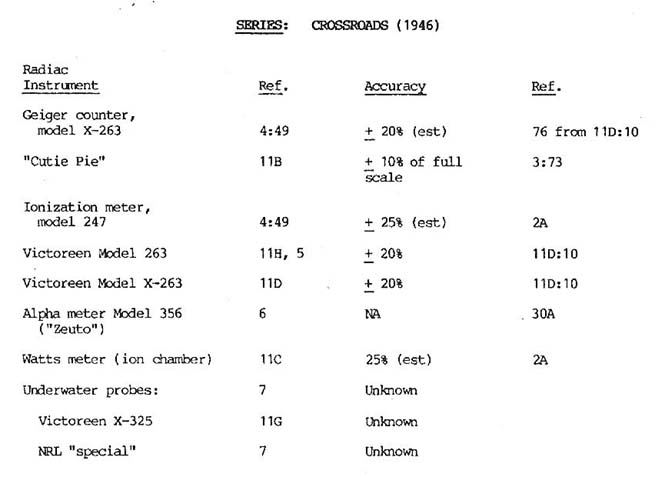
Operation Crossroads - late 1940's
The Operations Crossroads series of nuclear tests in the Pacific required new instrumentation. The Pacific test, conducted in 1946-1947, benefited the Victoreen company which provided most of the survey meter instrumentation. The tests were conducted under the auspices of Col. Stafford L. Warren, Chief Radiological Safety Officer. At this time, the Navy encountered contaminated ships. Due to the lack of radiation instruments in the Army inventory, the Bureau of Ships began a program to develop radiation monitoring instruments. During this time, the Dept of the Navy turned to big business to address its needs. The AEC, with its growing radioisotope program turned to smaller companies for assistance. In 1949, the US military began to place significant orders for radiation measuring instruments. In 1946, yearly sales of instruments was $800,000. In 1949, it was estimated to be $4,500,000.

Chart showing detectors used at Operation Crossroads 1946
Several portable detection instruments were used during Operation Crossroads in 1946. The Geiger Counter Model X-263, Cutie Pie, Victoreen Model 247, Victoreen Model 263, Victoreen Alpha Meter Model 356 (Zeuto), Watts Meter, and underwater probes to include the Victoreen Model X-325 and NRL "Special".
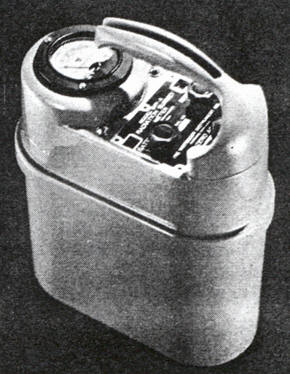
Victoreen Model 247A 1948
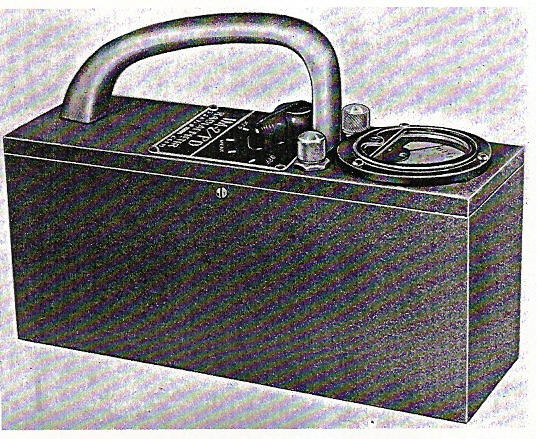
Victoreen Model X-263 1946
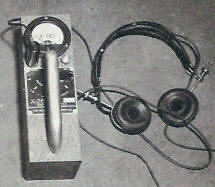
Victoreen Model X-263 1946
The Model X-263 was used by Col. Stafford Warren who was the medical direction for the Manhattan Project. He was also in charge of radiation safety at the Trinity Test in 1945. Performance tests in March 1946 show that the unit was tested in aircraft to 30,000 feet at Wright Field, Ohio by flight surgeons of the US Navy. The old Geiger Mueller Model X-263 was not reliable at the Crossroads Tests. The unit had been designed in a hurry to meet new requirements not available with the larger Model 263 series. It was described as “adequate on the desk of a meticulous old lady in an air conditioned laboratory, but not useful in boats.”
The Model 263 was offered in 1948 as a production model of the X-263. The GM tube is located inside a probe which has a beta window. It had a meter and headphone for indications.
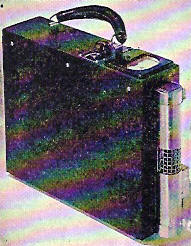
Victoreen Model 263 1947
The Victoreen Model 345 Alpha Survey Meter was introduced in 1949 for measuring moderate levels of alpha and beta radiation. It had a thin, flat air ionization chamber on the bottom and a thin nylon film window on the bottom. The window is protected by a wire screen. It had two ranges for alpha and beta. The X-1 range (5000 dpm alpha and 20 mR/h beta) and the X-10 range (50,000 dpm alpha and 200 mR/h beta).
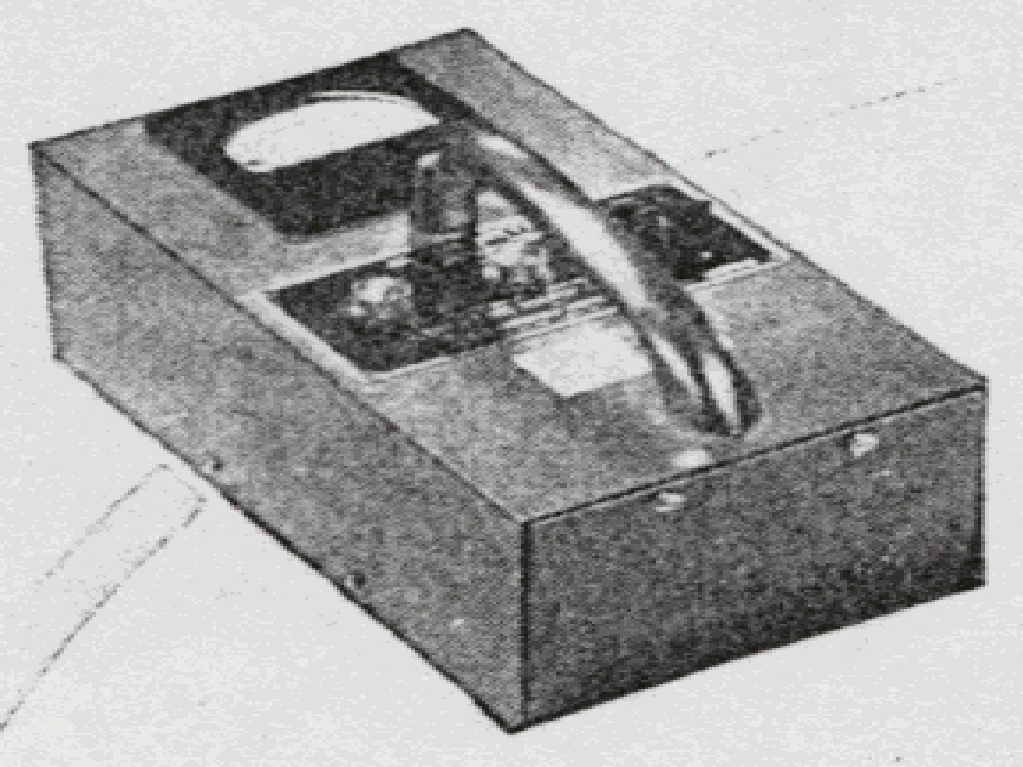
Victoreen Model 345 Alpha Meter 1949
In 1947, Victoreen produced the Model 356 Alpha Survey Meter for alpha detection for use during Operation Sandstone. Not sure if this is the same as the Pluto Alpha Meter from the same period. This was also designated by the military as the IM-4/PD.

Victoreen Alpha Survey Meter Model 356 1948
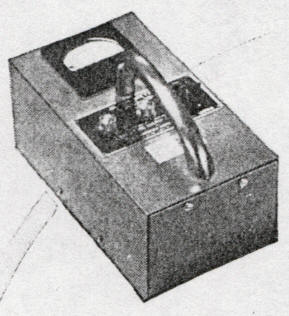
Victoreen Alpha Survey Meter Model 356 1949
The Zeuto (Zuto) Alpha Survey Meter Model 356 is a portable alpha contamination meter designed after the Zeuto (MDDC-117) developed by the Metallurgical Laboratory at the University of Chicago. It was manufactured commercially by Victoreen in Jul 1947 and also designated as IM-4/PD for the military. It has an air ionization chamber. It weighs 8 lbs. It could detect alpha from 400 dpm and 40000 dpm, beta and gamma from 4 mR/h and 40 mR/h. There were no screens to discriminate type of radiation. It has an air ionization chamber operating at atmospheric pressure. The walls of the chamber form the cathode and the anode consists of a wire framework referred to as the “tree”. The ion chamber had a very thin nylon screen and was 475 cc. It was coated in aquadag. The minimum energy detected was 25 keV beta and 2 MeV alpha. It used one 1.5V battery for the filament, two 7.5V for the coupling and bias, and two 22.5 V for the plate and chamber. It was also designated AN/1 M-4PD. It was 9.5”x5.25”x4.25” and weighed 6-8 lbs.
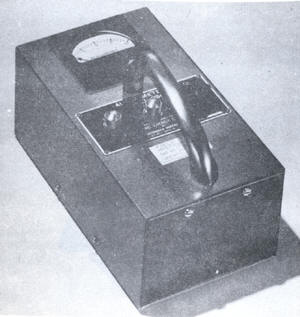
Victoreen Alpha Survey Meter Model 356 1950
The following section provides a few photographs from the 1950's with military soldiers using radiation detection equipment in exercises.
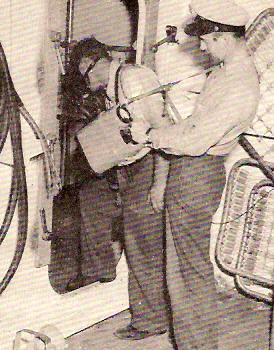
Dose measurement using Victoreen Model 247 before entering a compartment on a ship 1950's
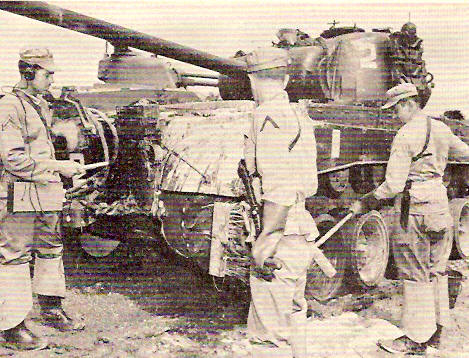
Contamination measurement with a portable GM detector after decontaminating a tank 1950's
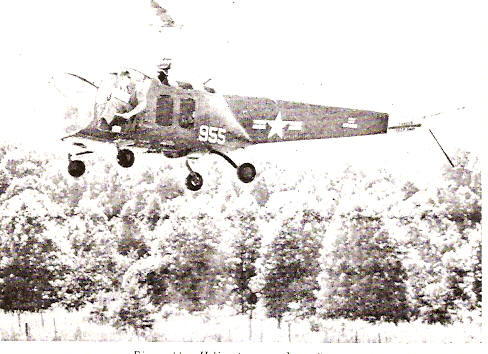
Helicopter with RADIAC to probe for ground contamination 1950's

Hand survey for contamination 1950's
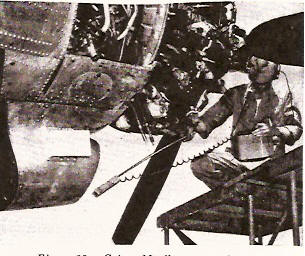
An airplane survey with a AN/PDR-8 long probe meter 1950's
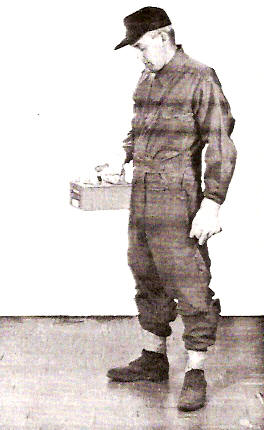
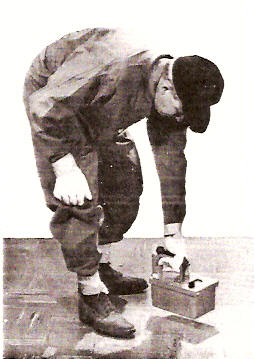
Measurements at 3 feet and at the ground surface 1950's
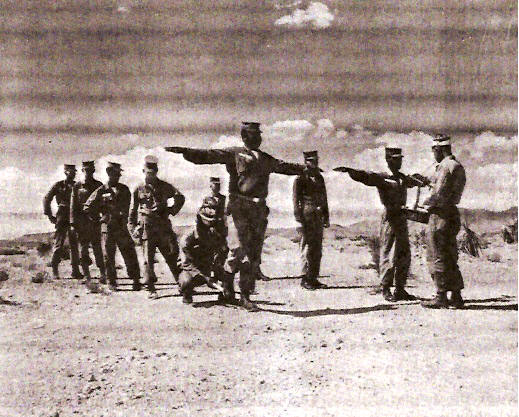
Surveying personnel at a decontamination line 1950's

Radiation measurement from a jeep 1950's
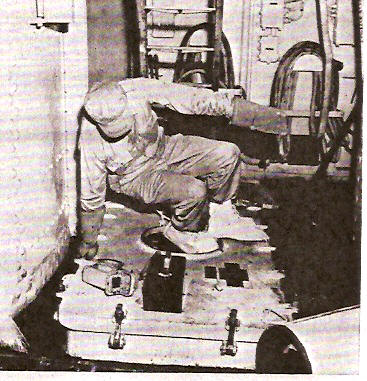
Surveying a passage way on a ship 1950's
Many companies were concerned that atmospheric testing would results in contamination of their products. American Felt Company made wool and other fibers used in making felt for industrial filtration. The ad below notes that American kept an Geiger counter on in its labs for monitor for radioactive atomic particles.
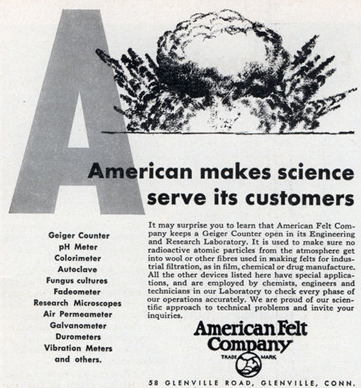
American Felt Company uses a Geiger counter to monitor for radioactive atomic particles 1950's